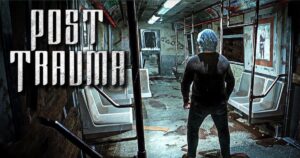Post Trauma is a survival horror game that adamantly withholds answers, which I greatly appreciate.
In the women’s restroom, a hand is emerging from the toilet, searching in the air as if seeking for something. It’s bizarre – this entire location is bizarre. It’s a hospital ward filled with a fleshy, strange infestation of… something from another world. Fleshy vines block the doors and large fleshy pipes bulge occasionally as something moves within. The air is tinged with darkness and malice. I am strongly reminded of the Upside Down from the show Stranger Things. It’s a perplexing place with strange inhabitants and rules that I can’t comprehend.

Somehow, there are mannequins positioned in unsettling poses – mannequins that appear to be in motion. In the midst of everything, there is myself, an elderly man (within the game!) who found himself in this miserable location. I don’t know why, but I do know that I want to leave. Everyone would. This location feels like a type of hell. And suddenly I realize: toilet paper! What could someone possibly be searching for in a bathroom other than toilet paper? It may seem uncomplicated, but it is effective. This problem has been figured out. I move on to the next one.

Trauma aftermath

Game creator: Red Soul Games
Raw Fury, the company that distributes the game.
Platform: Utilized on Personal Computer
Scheduled for launch in fall 2024 on PC (Steam), PlayStation 5, and Xbox Series X/S.

Summed up briefly, Post Trauma is a fresh survival horror game created by Raw Fury and Red Soul Games. I use the word “new” but it’s likely more appropriate to describe it as old. Old in terms of gameplay and influences: drawing inspiration from classic games like Silent Hill and Resident Evil. This is the main reason why this game feels slower and more clumsy compared to the modern games I am accustomed to. Consider: static camera perspectives, specified save locations, and absence of a map. Consider: challenging riddles and a lack of catering to your every desire.

In the demo of Post Trauma, I am situated in the hospital ward throughout the entire gameplay. Instead of moving through it as a temporary location, the ward acts as a contained playground where I navigate in circles, solving a series of puzzles along the way. Certain puzzles can be found within specific rooms, such as a computer in an archive room that requires a password obtained from nearby clues. Likewise, a hammer is enclosed in a locked box in a different room, and I can figure out the combination from a puzzle displayed on the wall. Both of these puzzles are quite challenging – the game does not simply provide the solution.
The more I explore the hospital ward floor, the more complex the puzzles become. I come across a blood sample machine that I can tell I will need to collect blood samples for, but I am uncertain where to obtain them from. I come across a grotesque creature moving on a surface that I realize I will eventually need to confront, although I am unsure of how to proceed. I encounter vending machines and peculiar books, puzzles and historical information, and I believe it will all be relevant for solving something eventually, but I’m uncertain when. I circle the ward once more, searching for the next domino piece necessary to advance the game. Paper for the toilet!

There are others present with me here as well. In the demo I am playing, there is a bulbous creature with two legs and multiple hands posing a threat as it wanders through the corridors. If I come into its sight, it will pursue me, and unfortunately, I learned that I can die. However, I have a way to protect myself now that I have removed the hammer from the lockbox. I am able to clumsily battle and defeat the monster, whether by subduing it or killing it – the outcome is uncertain. No matter what occurred, it withdraws, making the area seem safe again to continue patrolling, which is comforting. However, despite its absence, there is a foreboding feeling that it could come back, and those creepy mannequins I previously mentioned are still there, in uncomfortable poses catching me off guard. I am unsure of their capabilities, and the flickering darkness is only fueling my imagination instead of calming it. One of them is literally holding a scalpel.
However, Post Trauma is not particularly frightening. Anxious, possibly, and unsettling, certainly, but nothing truly startles me. That doesn’t bother me. I actually like it when it’s not overly trying to frighten me, but rather allowing a feeling of unease to gradually develop. It refers to a game that takes its time, a game that is self-assured, or perhaps just defiant, challenging my thoughts. Post Trauma offers no guidance on direction and does not provide subtle clues. It allows me to get angry and simmer. Initially, I found it unsettling, but as I got used to it, I began to feel a sense of appreciation. It’s similar to viewing an old movie and needing time to get used to the extended scenes; it may take time to adjust but eventually, you’ll find a timeless quality. Post Trauma possesses a bit of that element. It’s a game that appreciates intelligence and I believe attracts it, and I really enjoy that aspect.





